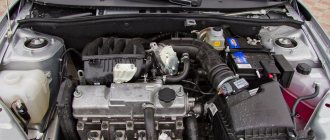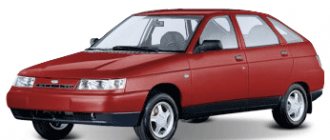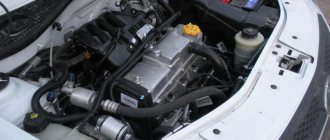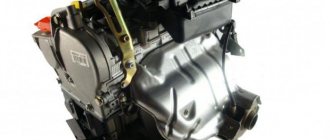I propose to discuss the new eight-valve engine with the VAZ-21116 index - this is a deep modernization of the 1.6-liter engine (VAZ-21114). When buying a car, I heard a lot about the upgraded engine from Granta (the norm). I knew that some kind of lightweight piston group was installed. Winter has come :), I have more time and decided to learn more about the engine. I am pleased with everything that the designers have done with the modernization of the engine, and the fact that the H-intake module has been improved, the pistons have been lightened, the collector has become quieter, and the timing belt tensioner has become automatic. Everything is great except the big one BUT
, which constantly keeps you in suspense.
When the timing belt breaks, the valves bend
and lead to expensive repairs. I’m not used to thinking positively about the domestic engine industry. The manufacturer promised that the timing belt will last 200,000 km, which is hard to believe. And the coolant pump has been improved. I don’t believe that it won’t require replacement no sooner than the car has run 180,000 km. As a rule, a pump malfunction provokes a break in the timing belt. The day before yesterday, a neighbor complained that the timing belt on his car (VAZ-2114) had broken. Work for an hour, replaced with a new one and back on the road. This won't work on Grant anymore. It is necessary to constantly inspect the condition of the timing belt and the condition of the coolant pump. It is well written about the engine HERE: www.zr.ru/a/422396/ cooling system: www.vwts.ru/cooling/cooling_syst_el_regul_rus.pdf
What is your opinion?
This engine on cars of the first years of production had the index 21116, later, without significant technical changes, it received the index 11186, maintaining all its indicators. According to some information, the change in the index is associated with a change in the supplier of the connecting rod and piston group; if in engine 21116 the supplier was Federal Mogul, then in the engine with index 11186 AvtoVAZ independently mastered the production of ShPG.
Engine 21116 is another representative of the power units produced for the Lada Granta. It is considered one of the best representatives of the AvtoVAZ production family. Production of the power unit began in 2011 and continues.
1_no_copyright
The modernization of the eight-valve VAZ-21114 engine was brought closer by two major events: the release of Grants to the market and the transition of the entire model range to the next environmental level - Euro-4. And although the old 1.6-liter, despite its advanced age (its roots stretch back to the mid-80s of the last century), did not look like a frail old man, new standards and trends required extensive changes. At the same time, the possibilities for maneuver for motorists, as often happens, were narrowed by financial limits.
Therefore, we went along the already beaten path. After all, several years earlier, a 16-valve engine of the same volume (VAZ-21126) underwent an update, on which some technical solutions were tested. Moreover, they were able to unify not only the approach, but also many details, for example, a connecting rod with liners, a piston pin and rings. The cylinder block, although with its own index, is exactly like that of the VAZ-21126 engine: with additional nozzles for cooling the pistons with oil and plate-honing of the cylinder walls, which reduces the break-in time.
However, it was not possible to copy all the changes exactly: organizing the workflow in an engine with two valves per cylinder is more difficult. Moreover, the requirements for the modernized eight-valve engine turned out to be stricter. Take, for example, the resource - 160 thousand km for the VAZ-21126 and 200 thousand km for the VAZ-21116. Photos with captions will tell you what was changed and why.
Reliability, weaknesses, maintainability
Reliability
VAZ-21116 is considered a reliable engine. Many car owners are especially pleased with its low-end response. Traction at low speeds is quite satisfactory. Low gasoline consumption also did not go unnoticed.
But there is another category of car enthusiasts who are not satisfied with some of the nuances in the engine. For example, the absence of hydraulic compensators, and therefore frequent adjustment of valve thermal clearances.
There is an inconvenience in this situation, but it does not affect the reliability of the engine. In addition, there are complaints about minor problems during intensive use of the motor. However, this is understandable - the more you drive, the sooner some kind of malfunction will appear. This feature is typical for any engine.
Car service workers express their expert opinion about the VAZ-21116. In their opinion, the motor is absolutely reliable. For the most part, this is due to its configuration with imported parts and components.
Various modifications to internal combustion engine systems significantly increase reliability. So, instead of a mechanical fuel pedal, an electromechanical throttle module (“E-Gas”) is used.
Thanks to this innovation, the ECU controls both the gasoline supply and the air supply. The adjusted mixture enters the cylinders.
Increased reliability of the gas joint. Ultimately, cylinder deformation was significantly reduced. This leads to increased reliability of the engine as a whole, and also has a positive effect on increasing its service life.
Changes in the timing drive have increased its service life. The timing belt has become more reliable. But you shouldn’t be 100% deluded by this. The fact is that as a result of untimely or reduced maintenance, the bearings of the automatic tensioner or water pump can jam, which is rare, but it does happen.
Weak spots
The weaknesses of the VAZ-21116 are characterized by typical flaws of the manufacturer.
Unstable idle speed. The malfunction begins to appear when the sensors fail or problems occur in the operation of the electronic control of the fuel pedal (E-Gas).
In this case, the malfunction can only be detected by diagnosing the engine at a specialized car service center.
Misaligned valves contribute to the appearance of loud knocking noises in the engine compartment. It’s worse if the “authors” of the unauthorized knocking are the main or connecting rod bearings of the crankshaft.
As a rule, extreme wear of the liners causes them to make a loud knock. An inspection of the engine at a service station will reveal the malfunction.
Engine tripping. In most cases, the fault lies with a faulty ignition coil. You need to know that such engine behavior is possible when the valves burn out. And again, you can’t do without a car service.
Overheating of the motor can occur due to a faulty thermostat, or, less commonly, a fan. The malfunction can be easily determined by a decrease in the coolant level and the presence of coolant leaks. Service station specialists will help you find the cause of overheating.
The main trouble is a broken timing belt. In this case, bending of the valves is inevitable.
The belt breaks due to a breakdown of the water pump (a unit not completed by the manufacturer).
As you can see, the culprit of engine weaknesses is mainly the manufacturer. But this does not mean that every engine goes through these thorns.
H
H
Using computer modeling, we selected the optimal flow section of the gas channels, improving their throughput and reducing inlet losses. Since the power was increased, the engine became more thermally loaded, so it was necessary to include an additional operation in the technological process - heat treatment. By the way, all 16-valve heads pass it. In addition, for the sake of more efficient heat removal, the cross-section of the cooling channels was increased, but only those that really needed it.
Dynamics
External view of engine 21116
This is not a racing car, but there is enough power for both city driving and highway driving. If we compare it with the 16-valve engine of the Lada Granta, which is installed on the Luxury versions, then it has more torque at the bottom. This means that you can drive in 5th gear at a speed of 40 km/h.
For example, you are driving at 5 speed, the traffic light in front lights up red. You release the gas pedal and the car brakes with the engine. The light turns green and you can continue driving in 5th gear even if the vehicle speed has dropped to 40 km/h.
I was pleasantly surprised by the elasticity of the motor. Considering that I previously owned a Priora, and it has a 98 hp engine, then the engine is 87 hp. I like grants better.
H
H
It not only frees you from unnecessary operations, but also ensures correct tension, which affects the service life no less than the quality of the belt itself. If you overtighten, the roller and water pump bearings will suffer. The latter, by the way, has also been modernized: a more reliable bearing and oil seal have been installed, and the performance has also been increased (the unit is from a sixteen-valve engine, only with a pulley for a narrow belt).
Service
Maintenance 21116, typical for cars produced by AvtoVAZ. The main maintenance operations are changing the oil and oil filter. To change the lubricant, 3.2 liters of engine oil is required. In turn, 3.5 liters of lubricant fits into the engine.
It is recommended to fill in semi-synthetic motor oils marked 5W-30, 5W-40, 10W-40, 15W40.
The maintenance map looks like this:
TO-1: Oil change, oil filter replacement. Carry out after the first 1000-1500 km. This stage is also called the break-in stage, since the engine elements are grinding in.
TO-2: The second maintenance is carried out after 10,000 km. So, the engine oil and filter are changed again, as well as the air filter element. At this stage, the pressure on the engine is also measured and the valves are adjusted.
TO-3: At this stage, which is performed after 20,000 km, the standard procedure for changing the oil, replacing the fuel filter, as well as diagnosing all engine systems is carried out.
TO-4: The fourth maintenance is perhaps the simplest. After 30,000 km, only the oil and oil filter element are changed.
TO-5: The fifth maintenance is like a second wind for the engine. This time a lot of things are changing. So, let's look at which elements need to be replaced in the fifth maintenance:
- Change of oil.
- Replacing the oil filter.
- Replacing the air filter.
- Replacing the fuel filter element.
- The timing belt and roller are replaced.
- Alternator belt if necessary.
- Water pump.
- Valve cover gasket.
- Other items that need to be replaced.
- Valve adjustment, which adjusts the gas distribution mechanism.
Subsequent maintenance is carried out according to the 2-5 maintenance map for the corresponding mileage.
Nikolay GANYUSHKIN, head of the engine design bureau
The modernization of the eight-valve engine for front-wheel drive models took two years. The main goals were to reduce fuel consumption and increase dynamic performance by reducing mechanical engine losses, and at the same time reducing harmful vibrations and noise. And of course, increased reliability. Euro 4 standards require that the engine maintain its original emissions parameters twice as long - up to 160 thousand km. And we almost doubled the resource: from 120 thousand to 200 thousand km. The connecting rod and piston group of the VAZ-21116, like the sixteen-valve one, is purchased. In the future, we plan to produce some parts ourselves, and we will continue to purchase some from foreign partners from the Federal Mogul group, who intend to localize the production of components in Russia. We also take into account the interests of the Renault-Nissan alliance. If engine production volumes increase, then it would be reasonable to purchase additional equipment and organize the production of connecting rod and piston group parts in Togliatti.
New VAZ-21116 engine: with a light heart
Malfunctions and repairs
ICE 21116 is based on the 21114 power unit. Unlike its older brother, the piston group is produced by Federal Mogul, which made it possible to lighten the ShPG by 39%. If the timing belt breaks, the valve must bend. These are perhaps serious shortcomings. If the valves are bent, then a major overhaul of the cylinder head is guaranteed.
Frequent malfunctions of 21116 are tripping, and poor starting is due to poor quality of the ignition system and the formation of an air-fuel mixture that does not burn completely.
But these malfunctions are typical for all AvtoVAZ representatives. In this case, the car may still be under warranty service.
What cars was it used in?
The 21116 engine was created for all car models produced at that time:
- Lada Kalina-2 – station wagon, hatchback and sedan;
- Lada Priora – sedan, station wagon and hatchback;
- Lada Granta – sedan and liftback.
Improved engine characteristics provide a potential of 120 hp. With. without critical wear or 180 l. With. with loss of resource.
Characteristics
| engine's type | Petrol |
| Power | 90 hp (66 kW) |
| Torque | 143 at 3500 rpm |
| Volume | 1.6 l (1,597 cc) |
| Design | in-line |
| Fuel type | petrol |
| Supply system | Electronically controlled distributed injection |
| Compression | 10.5 |
| Cylinder diameter | 82 mm |
| Piston stroke | 75.6 mm |
| Number of cylinders | 4 |
| Number of valves | 8 |
| Petrol | AI-95 |
| Cylinder operating order | 1-3-4-2 |
| Candles | А17ДВРМ, NGK BPR6ES |
Maintenance
According to the manufacturer's requirements, engine 21116 must be serviced at the following intervals:
| Maintenance object | Time, year or km mileage, whichever comes first |
| Timing belt | 100000 |
| Battery | 1/20000 |
| Valve clearance | 2/20000 |
| Crankcase ventilation | 2/20000 |
| Belts that drive attachments | 10/200000 |
| Fuel line and tank cap | 2/40000 |
| Motor oil | 1/10000 |
| Oil filter | 1/10000 |
| Air filter | 1 – 2/40000 |
| Fuel filter | 4/40000 |
| Heating/Cooling Fittings and Hoses | 2/40000 |
| Coolant | 2/40000 |
| Oxygen sensor | 100000 |
| Spark plug | 1 – 2/20000 |
| Exhaust manifold | 1 |
Initially, the design included the simplest possible internal combustion engine device for independent power tuning and overhaul on its own.
Reviews from car owners about the 87 hp engine.
Most reviews are positive.
Mostly problems occur due to low-quality fuel and lubricants. The engine may start to stall and run intermittently (floating idle, stalls, loss of power, etc.). In this case, the “Check Engine” malfunction icon (indicator) should light up on the instrument panel.
The engine pulls well at low end; on the highway, even with a full load, there is enough power. This is especially noticeable when compared with a Ford Focus automatic: engine capacity 1.6, power 100 horsepower. Granta drives more fun, Focus “deflates” after 80 km per hour. As for Focus - personal experience, I owned just such a car.
Fuel consumption
Even in a mixed cycle with traffic jams, consumption will not exceed 10 liters per hundred!
Fuel consumption is good. Even in a mixed cycle with traffic jams, consumption will not exceed 10 liters per hundred. My consumption is 8 liters in the city, 6 on the highway. This is on 92 gasoline. I checked from tank to tank, it roughly matches the readings of the on-board computer. On 95 gasoline, which is what AvtoVAZ recommends using, fuel consumption should become even less.
If your consumption exceeds the norm, then you need to look for a malfunction. Do not delay troubleshooting, as your engine may be overloaded.
Starting in the cold
In cold weather it starts, even after a long stay. The main thing is a good battery, a working fuel pump and power system.











